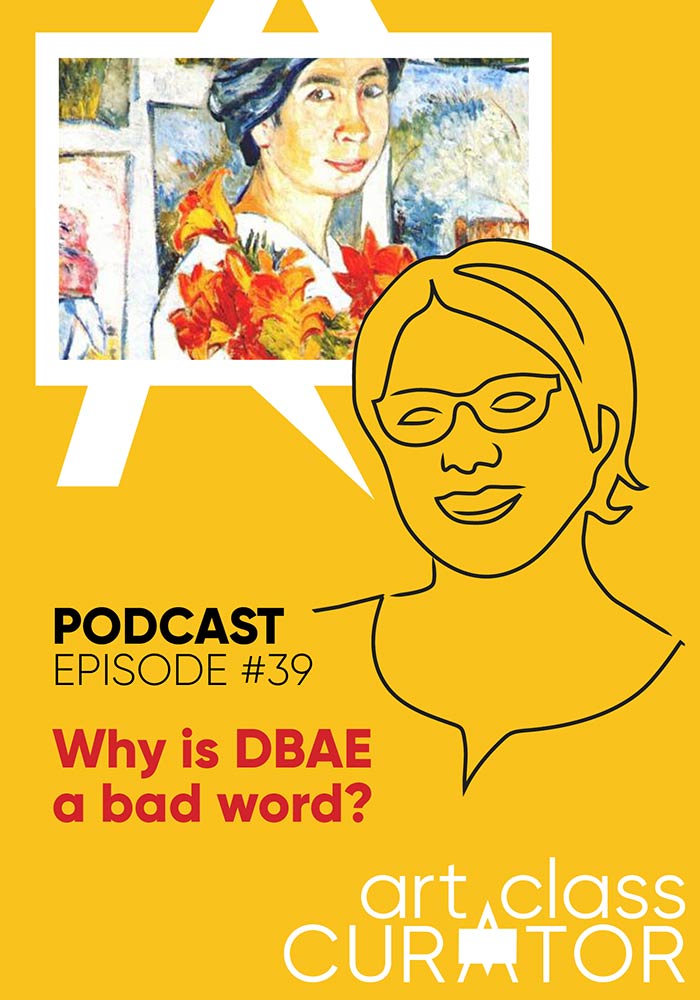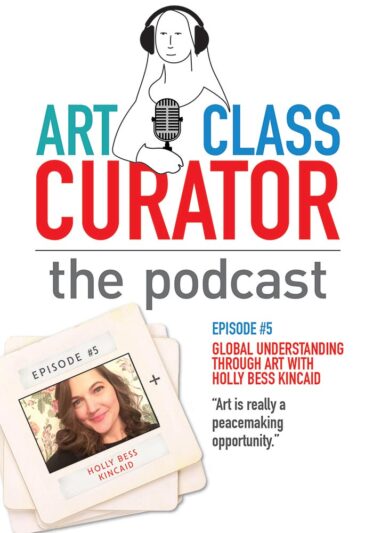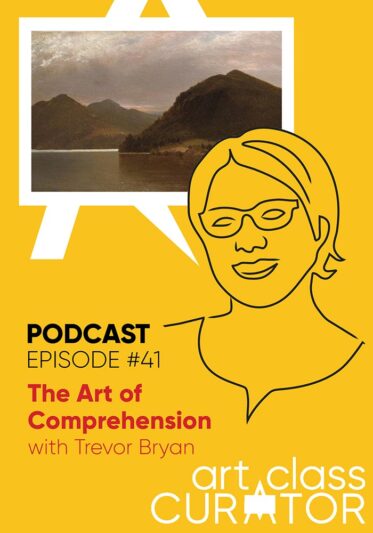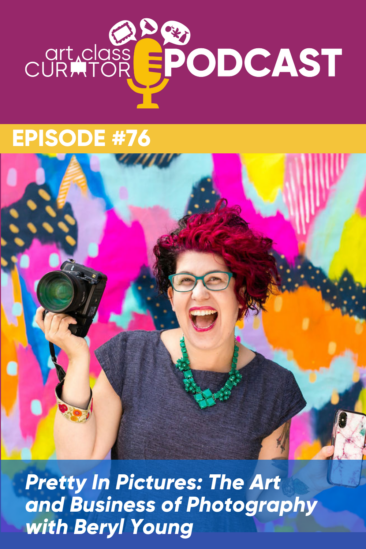While many art teachers still use Disciplined-Based Art Education (also known as DBAE) in their classrooms, it’s picked up a bad reputation. A lot of art education pedagogy discussions pit Teaching for Artistic Behavior (also known as TAB) against Disciplined-Based Art Education. The opinions are strong on both sides, but does it have to be either/or? Let’s talk about it.

Hello and welcome to the Art Class Curator Podcast. I am Cindy Ingram, your host and the founder of Art Class Curator and The Curated Connections Library. We’re here to talk about teaching art with purpose and inspiration from the daily delight to creativity to the messy mishaps that come with being a teacher. Whether you’re driving home from school or cleaning up your classroom for the 15th time today, take a second, take a deep breath, relax those shoulders and let’s get started.
Hello everybody. This is Cindy Ingram from Art Class Curator, and today what I want to talk about is DBAE and TAB. I started the idea with DBAE, which is Disciplined-Based Art Education. So that was really the foundation on how I was taught to teach art, that if you’re unfamiliar with the term, Disciplined-Based Art Education, it’s not necessarily taught as much anymore. They then eventually started to call it comprehensive art education, and then now, now it’s almost like a bad word. When you see it mentioned in Facebook groups, it’s like a derogatory term, which I think is really interesting, and I’ve always really wondered why.
So what Disciplined-Based Art Education is, and that is a total mouthful, is teaching art that’s not just studio but that you teach art history, art criticism, aesthetics and studio. So you’re not just doing sort of foundational studio class, that you’re including the other aspects of teaching art, which of course I have always resonated with. As you know, with Art Class Curator, we are dedicated to creating art connections and we do that through looking at works of art. So aesthetics, art criticism and art history are really firmly embedded into the type of teaching that I do.
When I would start to see people rail against DBAE, I didn’t really truly understand it because, for all intents and purposes, that is how I teach. So I started to do a little bit of research, and one, when I was recording that episode, I did a few back that was called, A Tale of Two Monet’s, about ditching the phrase “art appreciation” and how I don’t necessarily say that what we do at Art Class Curator is art appreciation or art history, that those are just the best words that we have to describe it. When I was recording that and planning that recording, that was the first time I ever really understood that DBAE isn’t exactly right either. So I started to understand a little bit about where people were coming from.
So what I did is I went into the art teachers Facebook group on Facebook, obviously, just the plain art teachers one, the one that has thousands and thousands of people in it. I just searched for DBAE, and apparently I am not the only one that was confused about why DBAE was so terrible because we have other people who are saying, “I don’t understand why DBAE is not a thing anymore. Why do we not like it? I don’t understand.” And then a lot of TAB people came in and be like, “Well, DBAE is not TAB.” And then other people are like, “Why can’t we do TAB and DBAE?” So it’s really kind of interesting to me.
TAB is Teaching for Artistic Behavior, which is an entire other teaching method focused on helping students become artists and think how artists think. But what I ultimately came across after reading all of these comments on Facebook and everything is that you know what? Who cares what it is that you’re calling your teaching. You can do a TAB classroom that is also DBAE. You can do a choice-based classroom that includes DBAE components. You don’t have to throw the baby out with the bathwater. You don’t have to throw all art appreciation out because you want artists to be, you want your young artists to become think like artists.
You don’t have to call your teaching anything. You can take a little bit from what I’m saying, a little bit from what someone else is saying. You can even do some cookie cutter projects for Christmas, and you’re totally fine. I did. Sometimes you just got to throw out a cookie cutter project every now and then because the kids like that, and if it’s not the all of your curriculum, you can still do some of that. So I’m making a case here for less rigid definitions of what we’re doing and more following your own intuition as a teacher because every art teacher is a completely different person. Every teacher is a completely different person. So there is no one-size-fits-all solution to your classroom.
For example, my classroom will look very different than a lot of other people’s classroom because I have really intense sensory processing issues. I’ve talked about that in that episode we did with Monica Wright and Amber Jordan. I forgot what we called it, but I’ll link to it in the show notes. I have very strong aversions to a lot of sound and a lot of movement in my classroom, and I find it to be really chaotic if I don’t have some sort of element of control or structure. If I create a really noisy, chaotic environment, I will be so drained at the end of the day that I can’t be a good teacher because I can’t… Controlling my energy is, I would say one of the most important roles in my life. I mean I know that sounds weird. But you controlling your energy and managing energy management of yourself is… is of utmost importance because you’re not going to be a good and effective teacher if you’re not listening to your own sensitivities and your own… I mean, my borderline neurotic behavior of how I have to have things.
But if you’re not like that, if you’re more loosey-goosey… Which I’ve never, I don’t think I’ve ever said that loosey-goosey out loud before. But if you are at a different personality, maybe you’re more extroverted, maybe you love all the chaos, you’re going to have a completely different classroom than I have. So we can both have elements of TAB. We can both have elements of choice-based. We can both have elements of DBAE. But ultimately it’s about structuring our own classroom in a way that fits us, our personalities and also our students.
Figuring out what works best for your students, what works best for you, that’s where you should start, that there are amazing resources online for any type of art that you want to teach, and you can pick and choose. You don’t have to be a TAB teacher, a DBAE teacher. So this is actually going in a completely different direction than I was planning. I was going to talk about how DBAE is, the elements of DBAE that I guess are good. I guess I could still do that.
In my research on art teachers Facebook group just to see what people were saying about DBAE, I found a link to Phyllis Brown’s blog post. Phyllis was on the podcast last year. She’s amazing, amazing woman, an amazing teacher, and amazingly dedicated to the field of art education. And she wrote a blog post and I love her blog post because she just lays it all out there. She just says what she’s thinking and I think it’s amazing. She wrote a blog post on May 6th of 2016, which I’ll link in the show notes, and it’s called, A Theoretical Renegade: Musings on Art Education and Education Theories and Jargon. And that’s this is basically what she was saying is, she says she’s been asked if she was a TAB teacher or DBAE teacher, and then her answer is, “Why do I have to be one or the other? Can’t I just be a little bit of both or neither?”
That’s you’ll be you. You do the things that are inspiring to you. If you are passionate that students should not see works of art because you think it will disrupt their artistic process, I mean, who am I to tell you not to do that? I don’t agree with you. Foundationally, I don’t agree with you, but that doesn’t mean that what you’re doing is any less valid than what I’m doing. So do whatever you think is right. So if you think adding choice-based is good, then do it. If you don’t, then don’t do it.
I am going to talk about what I like to do and why I think DBAE does miss the mark in some levels. So I think what classic DBAE does is your unit has the art criticism component, the art history component, the aesthetics component. You’re doing the discussion. You’re doing the research. You’re learning about the art, and then the studio project is then related to the art unit or art history or whatever that you’re studying. So maybe you’re doing, you’re studying a certain culture. You study their art and then you make a version of the type of things that they make.
Where I think that fails, and I think that’s a lot of the opinion of the TAB people, is that it is you want the art projects to be more substantial. You want them to have more choice, more personal reflection, personal expression, experimentation with media, that students need the opportunity to experiment and play and create and be original without given this sort of directed project to do. That’s why a lot of the projects that we do in our artwork lessons in the Curated Connection Library are just like prompts about the theme. So rather than making an artwork in the style of, we’re saying, okay, well, this artwork is about community. Let’s have you make an artwork about your idea of community. Maybe you write a poem about your community and then something like that, so that it’s more thematic, more about ideas, and then the student then can place their own, their own meaning on the theme and their own interpretation of that theme.
I hear a lot on those Facebook groups that they don’t want to show examples to students because they don’t want to direct where that student will go, which I do think it’s true. When I am doing a studio project, I often never did examples because I didn’t want students to just copy what I was doing. But also… I think that there’s flaws in that logic when it comes to showing them works of art from other artists.
Jennifer Easterling was on the podcast last week and we talked about how she uses the lessons from Art Class Curator in her classroom, especially with an artwork of the week that she does with her students. It struck home to me when I was talking to her that when we are showing works of art from all around the world, from different voices, diversity in voices, diversity in cultures and times and genders and all of that, diversity of ideas, we are showing our students what’s possible. We’re not closing them down and not limiting their expression. We’re opening up their expression. So when they see that artwork that Jennifer was talking about last week, the Shirin Neshat where they wrote the I am character poem over the picture of their face, they might have never considered the possibility that that could be an art form, that that could be something that they do to express themselves. That when they saw Sandy Sköglund’s Revenge of the Goldfish and the blue room with all the goldfish hanging, that might’ve sparked an idea in them that they would not have ever thought about because they didn’t know what was possible.
So, I think if you’re listening to this, you probably have views that are similar to my own, if you’re following this podcast. But opening up the eyes of our students to the possibilities in the world, that’s amazing. And it can be used to create better artists because when we show students things made by other people, it can only connect them with other people and bring them life and bring them ideas.
When I go to an art museum, I come away with idea after idea after idea, and usually, of course, my ideas are about teaching and how I would teach those artworks. But there’s always something I learned about me. There’s always something I learn about the world. There’s always something I learn about my community. There’s always something I come away with and I never know what that’s going to be, and so you don’t know what that’s going to be for your students. You can’t control what they’re going to take away. So maybe you will have a student that just outright copies it, but you’re going to have another student whose mind was blown and that it’s going to change the trajectory of whatever they end up doing. You never know what that’s going to be. So I think limiting what we show our students is problematic in that way.
I understand where everyone’s coming from along this scale of DBAE on one side and Teaching for Artistic Behavior on the other side, but there can be a middle and only you can determine where that middle is. Only you can determine what you’re going to do in your classroom. I mean, I guess you’ve got, sometimes you have curriculum in place that you have to do certain things certain ways. But a lot of us in our teaching roles don’t have that someone looking over our shoulder telling us what to do. We have a lot more freedom than our cohorts in other subjects, which I think is really exciting for us as teachers. I mean that’s a whole other conversation, should there be curriculum and should there not be curriculum? But that’s another podcast idea.
All right. Well, I think that was all I wanted to say about that. I was just really thinking about why is DBAE a bad word to many people, why is it not, and where I stand on the issue. So, in summary, do what you think is right and it doesn’t have to be one or the other. It can be your version and that is perfect. If you have someone who is criticizing your version of whatever you’re doing, like who cares because you are you. It’s your classroom. I mean, I guess if it’s your admin, I don’t know, then you can take their thoughts seriously. Don’t be pulled into all that drama on Facebook and just embrace what you’re doing and that if you’re following your gut and you’re following your heart, then you’re doing the right thing. So little encouragement for you there.
Thank you for listening and I will see you next time. Bye.
Thank you so much for listening to the Art Class Curator Podcast. Help more art teachers find us by reviewing the podcast and recommending it to a friend. Get more inspiration for teaching art with purpose by subscribing to our newsletter, Your Weekly Art Break. Recent topics include the importance of seeing art in-person, famous and should be famous women artists, and 21 days of art from around the world. Subscribe at artclasscurator.com/artbreak to receive six free art appreciation worksheets.
This week’s art quote is from Émile Zola. He says, “If you asked me what I came to do in this world, I, an artist, will answer you, I am here to live out loud.” Thanks so much for listening. Have a wonderful week.
Thanks for listening! Have an idea for an episode topic or think you may be a great guest for the show? Click here to send us an email telling us about it.
Subscribe and Review in iTunes
Have you subscribed to the podcast? I don’t want you to miss an episode and we have a lot of good topics and guests coming up! Click here to subscribe on iTunes!
If you are feeling extra kind, I would LOVE it if you left us a review on iTunes too! These reviews help others find the podcast and I truly love reading your feedback. You can click here to review and select “Write a Review” and let me know what you love best about the podcast!






Just loved this. I so agree. I cannot understand all this angst against DBAE. Most primary school children need it. They need experience and Exposure along with guidance. Let them grow and learn with support and direction. They have their whole life ahead of them to become an artist.